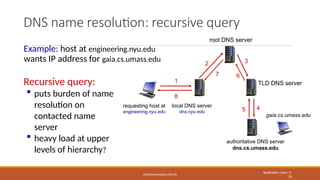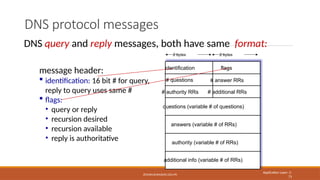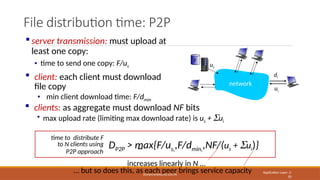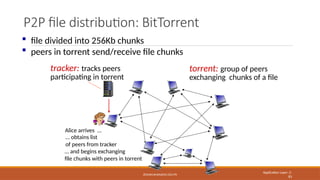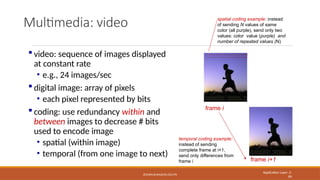CS3001_Computer_Networks_Chapter_2_v8.1.pptx
- 1. Chapter 2: Application Layer Lect ure Slides f rom the Boo k authors http://gaia.cs.umas s.edu/kuro se_ross / interactive/
- 2. Layers [email protected] Application Layer: 2-2 APPLICATION PRESENTATION SESSION TRANSPORT NETWORK LINK PHYSICAL
- 3. Chapter 2: Application layer [email protected] Application Layer: 2-3 Principles of network applications Web and HTTP E-mail, SMTP, IMAP The Domain Name System DNS P2P applications video streaming and content distribution networks socket programming with UDP and TCP
- 4. [email protected] Application layer: overview Our goals: conceptual and implementation aspects of application-layer protocols • transport-layer service models • client-server paradigm • peer-to-peer paradigm learn about protocols by examining popular application-layer protocols and infrastructure • HTTP • SMTP, IMAP • DNS • video streaming systems, CDNs programming network applications • socket API Application Layer: 2- 4
- 5. [email protected] Some network apps social networking Web text messaging e-mail multi-user network games streaming stored video (YouTube, Hulu, Netflix) P2P file sharing voice over IP (e.g., Skype) real-time video conferencing (e.g., Zoom, meet) Internet search remote login … Application Layer: 2- 5
- 6. [email protected] mobile network home network enterprise network national or global ISP local or regional ISP datacenter network content provider network application transport network data link physical application transport network data link physical application transport network data link physical Creating a network app Application Layer: 2- 6 write programs that: run on (different) end systems communicate over network e.g., web server software communicates with browser software no need to write software for network-core devices network-core devices do not run user applications applications on end systems allows for rapid app development, propagation
- 7. [email protected] mobile network home network enterprise network national or global ISP local or regional ISP datacenter network content provider network Client-server paradigm Application Layer: 2- 7 server: always-on host permanent IP address often in data centers, for scaling clients: contact, communicate with server may be intermittently connected may have dynamic IP addresses do not communicate directly with each other examples: HTTP, IMAP, FTP
- 8. [email protected] mobile network home network enterprise network national or global ISP local or regional ISP datacenter network content provider network Peer-peer architecture Application Layer: 2- 8 no always-on server arbitrary end systems directly communicate peers request service from other peers, provide service in return to other peers • self scalability – new peers bring new service capacity, as well as new service demands peers are intermittently connected and change IP addresses • complex management example: P2P file sharing
- 9. [email protected] Processes communicating Application Layer: 2- 9 process: program running within a host within same host, two processes communicate using inter-process communication (defined by OS) processes in different hosts communicate by exchanging messages note: applications with P2P architectures have client processes & server processes client process: process that initiates communication server process: process that waits to be contacted clients, servers
- 10. [email protected] Sockets Application Layer: 2- 10 process sends/receives messages to/from its socket socket analogous to door • sending process shoves message outdoor • sending process relies on transport infrastructure on other side of door to deliver message to socket at receiving process • two sockets involved: one on each side Internet controlled by OS controlled by app developer transport application physical link network process transport application physical link network process socket
- 11. [email protected] Addressing processes Application Layer: 2- 11 to receive messages, process must have identifier host device has unique 32-bit IP address Q: does IP address of host on which process runs suffice for identifying the process? A: no, many processes can be running on same host identifier includes both IP address and port numbers associated with process on host. example port numbers: • HTTP server: 80 • mail server: 25 to send HTTP message to gaia.cs.umass.edu web server: • IP address: 128.119.245.12 • port number: 80 more shortly…
- 12. [email protected] An application-layer protocol defines: Application Layer: 2- 12 types of messages exchanged, • e.g., request, response message syntax: • what fields in messages & how fields are delineated message semantics • meaning of information in fields rules for when and how processes send & respond to messages open protocols: defined in RFCs, everyone has access to protocol definition allows for interoperability e.g., HTTP, SMTP proprietary protocols: e.g., Skype, Zoom
- 13. [email protected] What transport service does an app need? Application Layer: 2- 13 data integrity some apps (e.g., file transfer, web transactions) require 100% reliable data transfer other apps (e.g., audio) can tolerate some loss timing some apps (e.g., Internet telephony, interactive games) require low delay to be “effective” throughput some apps (e.g., multimedia) require minimum amount of throughput to be “effective” other apps (“elastic apps”) make use of whatever throughput they get security encryption, data integrity, …
- 14. Transport service requirements: common apps [email protected] Application Layer: 2-14 application data loss throughput time sensitive? file transfer/download no loss elastic No e-mail no loss elastic No Web documents no loss elastic No real-time audio/video loss-tolerant audio: 5Kbps- 1Mbps video:10Kbps- 5Mbps yes, 10’s msec streaming audio/video loss-tolerant audio: 5Kbps- 1Mbps video:10Kbps- 5Mbps yes, few secs interactive games loss-tolerant Kbps yes, 10’s msec text messaging no loss elastic yes and no
- 15. [email protected] Internet transport protocols services Application Layer: 2- 15 TCP service: reliable transport between sending and receiving process flow control: sender won’t overwhelm receiver congestion control: throttle sender when network overloaded connection-oriented: setup required between client and server processes does not provide: timing, minimum throughput guarantee, security UDP service: unreliable data transfer between sending and receiving process does not provide: reliability, flow control, congestion control, timing, throughput guarantee, security, or connection setup. Q: why bother? Why is there a UDP?
- 16. Internet applications, and transport protocols [email protected] Application Layer: 2-16 Application application layer protocol transport protocol file transfer/download FTP [RFC 959] TCP e-mail SMTP [RFC 5321] TCP Web documents HTTP 1.1 [RFC 7320] TCP Internet telephony SIP [RFC 3261], RTP [RFC 3550], or proprietary TCP or UDP streaming audio/video HTTP [RFC 7320], DASH TCP interactive games WOW, FPS (proprietary) TCP or UDP
- 17. [email protected] Securing TCP Application Layer: 2- 17 Vanilla TCP & UDP sockets: no encryption cleartext passwords sent into socket traverse Internet in cleartext (!) Transport Layer Security (TLS) provides encrypted TCP connections data integrity end-point authentication TLS implemented in application layer apps use TLS libraries, that use TCP in turn cleartext sent into “socket” traverse Internet encrypted more: Chapter 8
- 18. Chapter 2: Application layer [email protected] Application Layer: 2-18 Principles of network applications Web and HTTP E-mail, SMTP, IMAP The Domain Name System DNS P2P applications video streaming and content distribution networks socket programming with UDP and TCP
- 19. Web and HTTP Transport Layer: 3- 19 web page consists of objects, each of which can be stored on different Web servers object can be HTML file, JPEG image, Java applet, audio file,… web page consists of base HTML-file which includes several referenced objects, each addressable by a URL, e.g., www.someschool.edu/someDept/pic.gif host name path name
- 20. HTTP overview Transport Layer: 3- 20 HTTP: hypertext transfer protocol Web’s application-layer protocol client/server model: • client: browser that requests, receives, (using HTTP protocol) and “displays” Web objects • server: Web server sends (using HTTP protocol) objects in response to requests HTTP request HTTP response HTTP request HTTP response iPhone running Safari browser PC running Firefox browser server running Apache Web server
- 21. HTTP overview (continued) Transport Layer: 3- 21 HTTP uses TCP: client initiates TCP connection (creates socket) to server, port 80 server accepts TCP connection from client HTTP messages (application-layer protocol messages) exchanged between browser (HTTP client) and Web server (HTTP server) TCP connection closed HTTP is “stateless” server maintains no information about past client requests protocols that maintain “state” are complex! past history (state) must be maintained if server/client crashes, their views of “state” may be inconsistent, must be reconciled aside
- 22. HTTP connections: two types Transport Layer: 3- 22 Non-persistent HTTP 1. TCP connection opened 2. at most one object sent over TCP connection 3. TCP connection closed downloading multiple objects required multiple connections Persistent HTTP TCP connection opened to a server multiple objects can be sent over single TCP connection between client, and that server TCP connection closed
- 23. Non-persistent HTTP: example Transport Layer: 3- 23 User enters URL: 1a. HTTP client initiates TCP connection to HTTP server (process) at www.someSchool.edu on port 80 2. HTTP client sends HTTP request message (containing URL) into TCP connection socket. Message indicates that client wants object someDepartment/home.index 1b. HTTP server at host www.someSchool.edu waiting for TCP connection at port 80 “accepts” connection, notifying client 3. HTTP server receives request message, forms response message containing requested object, and sends message into its socket time (containing text, references to 10 jpeg images) www.someSchool.edu/someDepartment/home.index
- 24. Non-persistent HTTP: example (cont.) Transport Layer: 3- 24 User enters URL: (containing text, references to 10 jpeg images) www.someSchool.edu/someDepartment/home.index 5. HTTP client receives response message containing html file, displays html. Parsing html file, finds 10 referenced jpeg objects 6. Steps 1-5 repeated for each of 10 jpeg objects 4. HTTP server closes TCP connection. time
- 25. Non-persistent HTTP: response time Transport Layer: 3- 25 RTT (definition): time for a small packet to travel from client to server and back HTTP response time (per object): one RTT to initiate TCP connection one RTT for HTTP request and first few bytes of HTTP response to return object/file transmission time time to transmit file initiate TCP connection RTT request file RTT file received time time Non-persistent HTTP response time = 2RTT+ file transmission time
- 26. Persistent HTTP (HTTP 1.1) Transport Layer: 3- 26 Non-persistent HTTP issues: requires 2 RTTs per object OS overhead for each TCP connection browsers often open multiple parallel TCP connections to fetch referenced objects in parallel Persistent HTTP (HTTP1.1): server leaves connection open after sending response subsequent HTTP messages between same client/server sent over open connection client sends requests as soon as it encounters a referenced object as little as one RTT for all the referenced objects (cutting response time in half)
- 27. HTTP request message Transport Layer: 3- 27 two types of HTTP messages: request, response HTTP request message: • ASCII (human-readable format) header lines GET /index.html HTTP/1.1rn Host: www-net.cs.umass.edurn User-Agent: Mozilla/5.0 (Macintosh; Intel Mac OS X 10.15; rv:80.0) Gecko/20100101 Firefox/80.0 rn Accept: text/html,application/xhtml+xmlrn Accept-Language: en-us,en;q=0.5rn Accept-Encoding: gzip,deflatern Connection: keep-alivern rn carriage return character line-feed character request line (GET, POST, HEAD commands) carriage return, line feed at start of line indicates end of header lines
- 28. HTTP request message: general format Transport Layer: 3- 28 request line header lines body method sp sp cr lf version URL cr lf value header field name cr lf value header field name ~ ~ ~ ~ cr lf entity body ~ ~ ~ ~
- 29. Other HTTP request messages Transport Layer: 3- 29 POST method: web page often includes form input user input sent from client to server in entity body of HTTP POST request message GET method (for sending data to server): include user data in URL field of HTTP GET request message (following a ‘?’): www.somesite.com/animalsearch?monkeys&banana HEAD method: requests headers (only) that would be returned if specified URL were requested with an HTTP GET method. PUT method: uploads new file (object) to server completely replaces file that exists at specified URL with content in entity body of POST HTTP request message
- 30. HTTP response message Transport Layer: 3- 30 status line (protocol status code status phrase) header lines data, e.g., requested HTML file Date: Tue, 08 Sep 2020 00:53:20 GMT Server: Apache/2.4.6 (CentOS) OpenSSL/1.0.2k-fips PHP/7.4.9 mod_perl/2.0.11 Perl/v5.16.3 Last-Modified: Tue, 01 Mar 2016 18:57:50 GMT ETag: "a5b-52d015789ee9e" Accept-Ranges: bytes Content-Length: 2651 Content-Type: text/html; charset=UTF-8 rn data data data data data ... HTTP/1.1 200 OK
- 31. HTTP response status codes Transport Layer: 3- 31 status code appears in 1st line in server- to-client response message. some sample codes: • request succeeded, requested object later in this message 200 OK • requested object moved, new location specified later in this message (in Location: field) 301 Moved Permanently • request msg not understood by server 400 Bad Request • requested document not found on this server 404 Not Found 505 HTTP Version Not Supported
- 32. Maintaining user/server state: cookies Transport Layer: 3- 33 Recall: HTTP GET/response interaction is stateless no notion of multi-step exchanges of HTTP messages to complete a Web “transaction” • no need for client/server to track “state” of multi-step exchange • all HTTP requests are independent of each other • no need for client/server to “recover” from a partially-completed-but-never- completely-completed transaction a stateful protocol: client makes two changes to X, or none at all time time OK OK unlock X OK update X X’ update X X’’ lock data record X OK X X X’ X’’ X’’ t’ Q: what happens if network connection or client crashes at t’ ?
- 33. Maintaining user/server state: cookies Transport Layer: 3- 34 Web sites and client browser use cookies to maintain some state between transactions four components: 1) cookie header line of HTTP response message 2) cookie header line in next HTTP request message 3) cookie file kept on user’s host, managed by user’s browser 4) back-end database at Web site Example: Susan uses browser on laptop, visits specific e-commerce site for first time when initial HTTP requests arrives at site, site creates: • unique ID (aka “cookie”) • entry in backend database for ID • subsequent HTTP requests from Susan to this site will contain cookie ID value, allowing site to “identify” Susan
- 34. Maintaining user/server state: cookies Transport Layer: 3- 35 client server usual HTTP response msg usual HTTP response msg cookie file one week later: usual HTTP request msg cookie: 1678 cookie- specific action access ebay 8734 usual HTTP request msg Amazon server creates ID 1678 for user create entry usual HTTP response set-cookie: 1678 ebay 8734 amazon 1678 usual HTTP request msg cookie: 1678 cookie- specific action access ebay 8734 amazon 1678 backend database time time
- 35. HTTP cookies: comments Transport Layer: 3- 36 What cookies can be used for: authorization shopping carts recommendations user session state (Web e-mail) cookies and privacy: cookies permit sites to learn a lot about you on their site. third party persistent cookies (tracking cookies) allow common identity (cookie value) to be tracked across multiple web sites aside Challenge: How to keep state? at protocol endpoints: maintain state at sender/receiver over multiple transactions in messages: cookies in HTTP messages carry state
- 36. Web caches Transport Layer: 3- 37 user configures browser to point to a (local) Web cache browser sends all HTTP requests to cache • if object in cache: cache returns object to client • else cache requests object from origin server, caches received object, then returns object to client Goal: satisfy client requests without involving origin server client Web cache client HTTP request HTTP response HTTP request HTTP request origin server HTTP response HTTP response
- 37. Web caches (proxy servers) Transport Layer: 3- 38 Web cache acts as both client and server • server for original requesting client • client to origin server Why Web caching? reduce response time for client request • cache is closer to client reduce traffic on an institution’s access link Internet is dense with caches • enables “poor” content providers to more effectively deliver content server tells cache about object’s allowable caching in response header:
- 38. Caching example Transport Layer: 3- 39 origin servers public Internet institutional network 1 Gbps LAN 1.54 Mbps access link Scenario: access link rate: 1.54 Mbps RTT from institutional router to server: 2 sec web object size: 100K bits average request rate from browsers to origin servers: 15/sec avg data rate to browsers: 1.50 Mbps Performance Access Link A=packet arrival rate (requests/second)=15/sec R=transmission rate (bits/second)=1.54M/s L=Packet size=100K Traffic Intensity=LA/R=100K*15/1.54M=0.97
- 39. Caching example Transport Layer: 3- 40 origin servers public Internet institutional network 1 Gbps LAN 1.54 Mbps access link Scenario: access link rate: 1.54 Mbps RTT from institutional router to server: 2 sec web object size: 100K bits average request rate from browsers to origin servers: 15/sec avg data rate to browsers: 1.50 Mbps Performance Institute LAN A=packet arrival rate (requests/second)=15/sec R=transmission rate (bits/second)=1G/s L=Packet size=100K Traffic Intensity=LA/R=100K*15/1G=0.0015
- 40. Caching example Transport Layer: 3- 41 origin servers public Internet institutional network 1 Gbps LAN 1.54 Mbps access link Performance: access link utilization = .97 LAN utilization: .0015 end-end delay = Internet delay + access link delay + LAN delay = 2 sec + minutes + micro secs Scenario: access link rate: 1.54 Mbps RTT from institutional router to server: 2 sec web object size: 100K bits average request rate from browsers to origin servers: 15/sec avg data rate to browsers: 1.50 Mbps problem: large queueing delays at high utilization!
- 41. Performance: access link utilization = .97 LAN utilization: .0015 end-end delay = Internet delay + access link delay + LAN delay = 2 sec + minutes + micro secs Option 1: buy a faster access link Transport Layer: 3- 42 origin servers public Internet institutional network 1 Gbps LAN 1.54 Mbps access link Scenario: access link rate: 1.54 Mbps RTT from institutional router to server: 2 sec web object size: 100K bits average request rate from browsers to origin servers: 15/sec avg data rate to browsers: 1.50 Mbps 154 Mbps 154 Mbps .0097 msecs Cost: faster access link (expensive!)
- 42. Performance: LAN utilization: .? access link utilization = ? average end-end delay = ? Option 2: install a web cache Transport Layer: 3- 43 origin servers public Internet institutional network 1 Gbps LAN 1.54 Mbps access link Scenario: access link rate: 1.54 Mbps RTT from institutional router to server: 2 sec web object size: 100K bits average request rate from browsers to origin servers: 15/sec avg data rate to browsers: 1.50 Mbps How to compute link utilization, delay? Cost: web cache (cheap!) local web cache
- 43. Calculating access link utilization, end-end delay with cache: Transport Layer: 3- 44 origin servers public Internet institutional network 1 Gbps LAN 1.54 Mbps access link local web cache suppose cache hit rate is 0.4: 40% requests served by cache, with low (msec) delay 60% requests satisfied at origin • rate to browsers over access link = 0.6 * 1.50 Mbps = .9 Mbps • access link utilization = 0.9/1.54 = .58 means low (msec) queueing delay at access link average end-end delay: = 0.6 * (delay from origin servers) + 0.4 * (delay when satisfied at cache) = 0.6 (2.01) + 0.4 (~msecs) = ~ 1.2 secs lower average end-end delay than with 154 Mbps link (and cheaper too!)
- 44. Conditional GET Transport Layer: 3- 45 Goal: don’t send object if cache has up-to-date cached version • no object transmission delay (or use of network resources) client: specify date of cached copy in HTTP request If-modified-since: <date> server: response contains no object if cached copy is up-to-date: HTTP/1.0 304 Not Modified HTTP request msg If-modified-since: <date> HTTP response HTTP/1.0 304 Not Modified object not modified before <date> HTTP request msg If-modified-since: <date> HTTP response HTTP/1.0 200 OK <data> object modified after <date> client server
- 45. HTTP/2 Transport Layer: 3-46 Key goal: decreased delay in multi-object HTTP requests HTTP1.1: introduced multiple, pipelined GETs over single TCP connection • server responds in-order (FCFS: first-come-first-served scheduling) to GET requests • with FCFS, small object may have to wait for transmission (head-of- line (HOL) blocking) behind large object(s) • loss recovery (retransmitting lost TCP segments) stalls object transmission
- 46. HTTP/2 Transport Layer: 3- 47 HTTP/2: [RFC 7540, 2015] increased flexibility at server in sending objects to client: methods, status codes, most header fields unchanged from HTTP 1.1 transmission order of requested objects based on client-specified object priority (not necessarily FCFS) push unrequested objects to client divide objects into frames, schedule frames to mitigate HOL blocking Key goal: decreased delay in multi-object HTTP requests
- 47. HTTP/2: mitigating HOL blocking Transport Layer: 3- 48 HTTP 1.1: client requests 1 large object (e.g., video file) and 3 smaller objects client server GET O1 GET O2 GET O3 GET O4 O1 O2 O3 O4 object data requested O1 O2 O3 O4 objects delivered in order requested: O2, O3, O4 wait behind O1
- 48. HTTP/2: mitigating HOL blocking Transport Layer: 3- 49 HTTP/2: objects divided into frames, frame transmission interleaved client server GET O1 GET O2 GET O3 GET O4 O2 O4 object data requested O1 O2 O3 O4 O2, O3, O4 delivered quickly, O1 slightly delayed O3 O1
- 49. HTTP/2 to HTTP/3 Transport Layer: 3- 50 HTTP/2 over single TCP connection means: recovery from packet loss still stalls all object transmissions • as in HTTP 1.1, browsers have incentive to open multiple parallel TCP connections to reduce stalling, increase overall throughput no security over vanilla TCP connection HTTP/3: adds security, per object error- and congestion- control (more pipelining) over UDP • more on HTTP/3 in transport layer
- 50. Chapter 2: Application layer [email protected] Application Layer: 2-51 Principles of network applications Web and HTTP E-mail, SMTP, IMAP The Domain Name System DNS P2P applications video streaming and content distribution networks socket programming with UDP and TCP
- 51. [email protected] E-mail Application Layer: 2- 52 Three major components: user agents mail servers simple mail transfer protocol: SMTP User Agent “mail reader” composing, editing, reading mail messages e.g., Outlook, iPhone mail client outgoing, incoming messages stored on server user mailbox outgoing message queue mail server mail server mail server SMTP SMTP SMTP user agent user agent user agent user agent user agent user agent
- 52. [email protected] E-mail: mail servers Application Layer: 2- 53 user mailbox outgoing message queue mail server mail server mail server SMTP SMTP SMTP user agent user agent user agent user agent user agent user agent mail servers: mailbox contains incoming messages for user message queue of outgoing (to be sent) mail messages SMTP protocol between mail servers to send email messages client: sending mail server “server”: receiving mail server
- 53. [email protected] SMTP RFC (5321) Application Layer: 2- 54 uses TCP to reliably transfer email message from client (mail server initiating connection) to server, port 25 direct transfer: sending server (acting like client) to receiving server three phases of transfer • SMTP handshaking (greeting) • SMTP transfer of messages • SMTP closure command/response interaction (like HTTP) • commands: ASCII text • response: status code and phrase initiate TCP connection RTT time 220 250 Hello HELO SMTP handshaking TCP connection initiated “client” SMTP server “server” SMTP server SMTP transfers
- 54. [email protected] Scenario: Alice sends e-mail to Bob Application Layer: 2- 55 1) Alice uses UA to compose e-mail message “to” [email protected] 4) SMTP client sends Alice’s message over the TCP connection user agent mail server mail server 1 2 3 4 5 6 Alice’s mail server Bob’s mail server user agent 2) Alice’s UA sends message to her mail server using SMTP; message placed in message queue 3) client side of SMTP at mail server opens TCP connection with Bob’s mail server 5) Bob’s mail server places the message in Bob’s mailbox 6) Bob invokes his user agent to read message
- 55. [email protected] SMTP: observations Application Layer: 2- 56 SMTP uses persistent connections SMTP requires message (header & body) to be in 7-bit ASCII SMTP server uses CRLF.CRLF to determine end of message comparison with HTTP: HTTP: client pull SMTP: client push both have ASCII command/response interaction, status codes HTTP: each object encapsulated in its own response message SMTP: multiple objects sent in multipart message
- 56. [email protected] Mail message format Application Layer: 2- 57 SMTP: protocol for exchanging e-mail messages, defined in RFC 5321 (like RFC 7231 defines HTTP) RFC 2822 defines syntax for e-mail message itself (like HTML defines syntax for web documents) header body blank line header lines, e.g., • To: • From: • Subject: these lines, within the body of the email message area different from SMTP MAIL FROM:, RCPT TO: commands! Body: the “message” , ASCII characters only
- 57. [email protected] Retrieving email: mail access protocols Application Layer: 2- 58 sender’s e-mail server SMTP SMTP receiver’s e-mail server e-mail access protocol (e.g., IMAP, HTTP) user agent user agent SMTP: delivery/storage of e-mail messages to receiver’s server mail access protocol: retrieval from server • IMAP: Internet Mail Access Protocol [RFC 3501]: messages stored on server, IMAP provides retrieval, deletion, folders of stored messages on server HTTP: gmail, Hotmail, Yahoo!Mail, etc. provides web-based interface on top of STMP (to send), IMAP (or POP) to retrieve e-mail messages
- 58. [email protected] SMTP vs IMAP SMTP (SIMPLE MAIL TRANSFER PROTOCOL) It is primarily used for sending emails from a client (such as an email application or server) to an email server or between email servers. It handles the process of sending outgoing emails, including routing emails to the appropriate recipient's email server. It operates on port 25 (although encrypted versions like SMTPS or SMTP over TLS may use different ports) and is responsible for transferring the email message from the sender's email client to the recipient's email server. IMAP (INTERNET MESSAGE ACCESS PROTOCOL) It is used for accessing emails stored on an email server from a client device (such as an email application or webmail client). It allows users to view, manage, and organize their email messages stored on the server without downloading them to the client device. It supports features like folder synchronization, allowing changes made on one device to be reflected on other devices accessing the same email account. It operates on port 143 (or 993 for IMAP over TLS/SSL) and provides a way for email clients to communicate with the email server to retrieve and manage emails. Application Layer: 2- 59
- 59. Chapter 2: Application layer [email protected] Application Layer: 2-60 Principles of network applications Web and HTTP E-mail, SMTP, IMAP The Domain Name System DNS P2P applications video streaming and content distribution networks socket programming with UDP and TCP
- 60. [email protected] DNS: Domain Name System Application Layer: 2- 61 people: many identifiers: • SSN, name, passport # Internet hosts, routers: • IP address (32 bit) - used for addressing datagrams • “name”, e.g., cs.umass.edu - used by humans Q: how to map between IP address and name, and vice versa ? Domain Name System (DNS): distributed database implemented in hierarchy of many name servers application-layer protocol: hosts, DNS servers communicate to resolve names (address/name translation) • note: core Internet function, implemented as application-layer protocol • complexity at network’s “edge”
- 61. [email protected] DNS: services, structure Application Layer: 2- 62 Q: Why not centralize DNS? single point of failure traffic volume distant centralized database maintenance DNS services: hostname-to-IP-address translation host aliasing • canonical, alias names mail server aliasing load distribution • replicated Web servers: many IP addresses correspond to one name A: doesn‘t scale! Comcast DNS servers alone: 600B DNS queries/day Akamai DNS servers alone: 2.2T DNS queries/day
- 62. [email protected] Thinking about the DNS Application Layer: 2- 63 humongous distributed database: ~ billion records, each simple handles many trillions of queries/day: many more reads than writes performance matters: almost every Internet transaction interacts with DNS - msecs count! organizationally, physically decentralized: millions of different organizations responsible for their records “bulletproof”: reliability, security
- 63. [email protected] DNS: a distributed, hierarchical database Application Layer: 2- 64 Client wants IP address for www.amazon.com; 1st approximation: client queries root server to find .com DNS server client queries .com DNS server to get amazon.com DNS server client queries amazon.com DNS server to get IP address for www.amazon.com .com DNS servers .org DNS servers .edu DNS servers … … Top Level Domain Root DNS Servers Root nyu.edu DNS servers umass.edu DNS servers yahoo.com DNS servers amazon.com DNS servers pbs.org DNS servers Authoritative … … … …
- 64. [email protected] DNS: root name servers Application Layer: 2- 65 official, contact-of-last-resort by name servers that can't resolve name
- 65. [email protected] DNS: root name servers Application Layer: 2- 66 official, contact-of-last-resort by name servers that can't resolve name incredibly important Internet function • Internet couldn’t function without it! • DNSSEC – provides security (authentication, message integrity) ICANN (Internet Corporation for Assigned Names and Numbers) manages root DNS domain 13 logical root name “servers” worldwide each “server” replicated many times (~200 servers in US)
- 66. [email protected] Top-Level Domain, and authoritative servers Application Layer: 2- 67 Top-Level Domain (TLD) servers: responsible for .com, .org, .net, .edu, .aero, .jobs, .museums, and all top-level country domains, e.g.: .cn, .uk, .fr, .ca, .jp Network Solutions: authoritative registry for .com, .net TLD Educause: .edu TLD authoritative DNS servers: organization’s own DNS server(s), providing authoritative hostname to IP mappings for organization’s named hosts can be maintained by organization or service provider
- 67. [email protected] Local DNS name servers Application Layer: 2- 68 when host makes DNS query, it is sent to its local DNS server • Local DNS server returns reply, answering: • from its local cache of recent name-to-address translation pairs (possibly out of date!) • forwarding request into DNS hierarchy for resolution • each ISP has local DNS name server; to find yours: • MacOS: % scutil --dns • Windows: >ipconfig /all local DNS server doesn’t strictly belong to hierarchy
- 68. [email protected] DNS name resolution: iterated query Application Layer: 2- 69 Example: host at engineering.nyu.edu wants IP address for gaia.cs.umass.edu Iterated query: contacted server replies with name of server to contact “I don’t know this name, but ask this server” requesting host at engineering.nyu.edu gaia.cs.umass.edu root DNS server local DNS server dns.nyu.edu 1 2 3 4 5 6 authoritative DNS server dns.cs.umass.edu 7 8 TLD DNS server
- 69. [email protected] DNS name resolution: recursive query Application Layer: 2- 70 requesting host at engineering.nyu.edu gaia.cs.umass.edu root DNS server local DNS server dns.nyu.edu 1 2 3 4 5 6 authoritative DNS server dns.cs.umass.edu 7 8 TLD DNS server Recursive query: puts burden of name resolution on contacted name server heavy load at upper levels of hierarchy? Example: host at engineering.nyu.edu wants IP address for gaia.cs.umass.edu
- 70. [email protected] Caching DNS Information Application Layer: 2- 71 once (any) name server learns mapping, it caches mapping, and immediately returns a cached mapping in response to a query • caching improves response time • cache entries timeout (disappear) after some time (TTL) • TLD servers typically cached in local name servers cached entries may be out-of-date • if named host changes IP address, may not be known Internet- wide until all TTLs expire! • best-effort name-to-address translation!
- 71. [email protected] DNS records Application Layer: 2- 72 DNS: distributed database storing resource records (RR) type=NS name is domain value is hostname of authoritative name server for this domain (foo.com, dns.foo.com, NS) RR format: (name, value, type, ttl) type=A name is hostname value is IP address (relay1.bar.foo.com, 145.37.93.126, A) type=CNAME name is alias name for some “canonical” (the real) name www.ibm.com is really servereast.backup2.ibm.com value is canonical name type=MX value is name of SMTP mail server associated with name
- 72. [email protected] identification flags # questions questions (variable # of questions) # additional RRs # authority RRs # answer RRs answers (variable # of RRs) authority (variable # of RRs) additional info (variable # of RRs) 2 bytes 2 bytes DNS protocol messages Application Layer: 2- 73 DNS query and reply messages, both have same format: message header: identification: 16 bit # for query, reply to query uses same # flags: • query or reply • recursion desired • recursion available • reply is authoritative
- 73. [email protected] identification flags # questions questions (variable # of questions) # additional RRs # authority RRs # answer RRs answers (variable # of RRs) authority (variable # of RRs) additional info (variable # of RRs) 2 bytes 2 bytes DNS query and reply messages, both have same format: name, type fields for a query RRs in response to query records for authoritative servers additional “ helpful” info that may be used DNS protocol messages Application Layer: 2- 74
- 74. [email protected] Getting your info into the DNS Application Layer: 2- 75 example: new startup “FAST” register name fast.com at DNS registrar (e.g., FAST.com) • provide names, IP addresses of authoritative name server (primary and secondary) • registrar inserts NS, A RRs into .com TLD server: (fast.com, dns1.fast.com, NS) (dns1.fast.com, 212.212.212.1, A) create authoritative server locally with IP address 212.212.212.1 • type A record for www.fast.com • type MX record for fast.com
- 75. [email protected] DNS security Application Layer: 2- 76 DDoS attacks bombard root servers with traffic • not successful to date • traffic filtering • local DNS servers cache IPs of TLD servers, allowing root server bypass bombard TLD servers • potentially more dangerous Spoofing attacks intercept DNS queries, returning bogus replies DNS cache poisoning RFC 4033: DNSSEC authentication services
- 76. Chapter 2: Application layer [email protected] Application Layer: 2-77 Principles of network applications Web and HTTP E-mail, SMTP, IMAP The Domain Name System DNS P2P applications video streaming and content distribution networks socket programming with UDP and TCP
- 77. [email protected] mobile network home network enterprise network national or global ISP local or regional ISP datacenter network content provider network Peer-to-peer (P2P) architecture Application Layer: 2- 78 no always-on server arbitrary end systems directly communicate peers request service from other peers, provide service in return to other peers • self scalability – new peers bring new service capacity, and new service demands peers are intermittently connected and change IP addresses • complex management examples: P2P file sharing (BitTorrent), streaming (KanKan), VoIP (Skype)
- 78. [email protected] File distribution: client-server vs P2P Application Layer: 2- 79 Q: how much time to distribute file (size F) from one server to N peers? • peer upload/download capacity is limited resource us uN dN server network (with abundant bandwidth) file, size F us: server upload capacity ui: peer i upload capacity di: peer i download capacity u2 d2 u1 d1 di ui
- 79. [email protected] File distribution time: client-server Application Layer: 2- 80 server transmission: must sequentially send (upload) N file copies: • time to send one copy: F/us • time to send N copies: NF/us client: each client must download file copy • dmin = min client download rate • min client download time: F/dmin us network di ui F increases linearly in N time to distribute F to N clients using client-server approach Dc-s > max{NF/us,,F/dmin}
- 80. [email protected] File distribution time: P2P Application Layer: 2- 81 server transmission: must upload at least one copy: • time to send one copy: F/us client: each client must download file copy • min client download time: F/dmin us network di ui F clients: as aggregate must download NF bits • max upload rate (limiting max download rate) is us + Sui time to distribute F to N clients using P2P approach DP2P > max{F/us,,F/dmin,,NF/(us + Sui)} … but so does this, as each peer brings service capacity increases linearly in N …
- 81. [email protected] Client-server vs. P2P: example Application Layer: 2- 82 client upload rate = u, F/u = 1 hour, us = 10u, dmin ≥ us 0 0.5 1 1.5 2 2.5 3 3.5 0 5 10 15 20 25 30 35 N Minimum Distribution Time P2P Client-Server
- 82. [email protected] P2P file distribution: BitTorrent Application Layer: 2- 83 file divided into 256Kb chunks peers in torrent send/receive file chunks tracker: tracks peers participating in torrent torrent: group of peers exchanging chunks of a file Alice arrives … … obtains list of peers from tracker … and begins exchanging file chunks with peers in torrent
- 83. [email protected] P2P file distribution: BitTorrent Application Layer: 2- 84 peer joining torrent: • has no chunks, but will accumulate them over time from other peers • registers with tracker to get list of peers, connects to subset of peers (“neighbors”) while downloading, peer uploads chunks to other peers peer may change peers with whom it exchanges chunks churn: peers may come and go once peer has entire file, it may (selfishly) leave or (altruistically) remain in torrent
- 84. [email protected] BitTorrent: requesting, sending file chunks Application Layer: 2- 85 Requesting chunks: at any given time, different peers have different subsets of file chunks periodically, Alice asks each peer for list of chunks that they have Alice requests missing chunks from peers, rarest first Sending chunks: tit-for-tat Alice sends chunks to those four peers currently sending her chunks at highest rate • other peers are choked by Alice (do not receive chunks from her) • re-evaluate top 4 every10 secs every 30 secs: randomly select another peer, starts sending chunks • “optimistically unchoke” this peer • newly chosen peer may join top 4
- 85. [email protected] BitTorrent: tit-for-tat Application Layer: 2- 86 (1) Alice “optimistically unchokes” Bob (2) Alice becomes one of Bob’s top-four providers; Bob reciprocates (3) Bob becomes one of Alice’s top-four providers higher upload rate: find better trading partners, get file faster !
- 86. Chapter 2: Application layer [email protected] Application Layer: 2-87 Principles of network applications Web and HTTP E-mail, SMTP, IMAP The Domain Name System DNS P2P applications video streaming and content distribution networks socket programming with UDP and TCP
- 87. [email protected] Video Streaming and CDNs: context Application Layer: 2- 88 stream video traffic: major consumer of Internet bandwidth • Netflix, YouTube, Amazon Prime: 80% of residential ISP traffic (2020) challenge: scale - how to reach ~1B users? challenge: heterogeneity different users have different capabilities (e.g., wired versus mobile; bandwidth rich versus bandwidth poor) solution: distributed, application-level infrastructure
- 88. [email protected] Multimedia: video Application Layer: 2- 89 video: sequence of images displayed at constant rate • e.g., 24 images/sec digital image: array of pixels • each pixel represented by bits coding: use redundancy within and between images to decrease # bits used to encode image • spatial (within image) • temporal (from one image to next) …………………….. spatial coding example: instead of sending N values of same color (all purple), send only two values: color value (purple) and number of repeated values (N) ……………….……. frame i frame i+1 temporal coding example: instead of sending complete frame at i+1, send only differences from frame i
- 89. [email protected] Multimedia: video Application Layer: 2- 90 …………………….. spatial coding example: instead of sending N values of same color (all purple), send only two values: color value (purple) and number of repeated values (N) ……………….……. frame i frame i+1 temporal coding example: instead of sending complete frame at i+1, send only differences from frame i CBR: (constant bit rate): video encoding rate fixed VBR: (variable bit rate): video encoding rate changes as amount of spatial, temporal coding changes examples: • MPEG1 (CD-ROM) 1.5 Mbps • MPEG2 (DVD) 3-6 Mbps • MPEG4 (often used in Internet, 64Kbps – 12 Mbps)
- 90. [email protected] Streaming stored video Main challenges: server-to-client bandwidth will vary over time, with changing network congestion levels (in house, access network, network core, video server) packet loss, delay due to congestion will delay playout, or result in poor video quality Application Layer: 2- 91 simple scenario: video server (stored video) client Internet
- 91. [email protected] Streaming stored video Application Layer: 2- 92 1. video recorded (e.g., 30 frames/sec) 2. video sent Cumulati ve data streaming: at this time, client playing out early part of video, while server still sending later part of video time 3. video received, played out at client (30 frames/sec) network delay (fixed in this example)
- 92. [email protected] Streaming stored video: challenges Application Layer: 2- 93 continuous playout constraint: during client video playout, playout timing must match original timing • … but network delays are variable (jitter), so will need client-side buffer to match continuous playout constraint other challenges: • client interactivity: pause, fast-forward, rewind, jump through video • video packets may be lost, retransmitted
- 93. [email protected] Streaming stored video: playout buffering Application Layer: 2- 94 constant bit rate video transmission Cumula tive data time variable network delay client video reception constant bit rate video playout at client client playout delay buffered video client-side buffering and playout delay: compensate for network-added delay, delay jitter
- 94. [email protected] Streaming multimedia: DASH Application Layer: 2- 95 server: divides video file into multiple chunks each chunk encoded at multiple different rates different rate encodings stored in different files files replicated in various CDN nodes manifest file: provides URLs for different chunks client ? client: periodically estimates server-to-client bandwidth consulting manifest, requests one chunk at a time • chooses maximum coding rate sustainable given current bandwidth • can choose different coding rates at different points in time (depending on available bandwidth at time), and from different servers ... ... ... Dynamic, Adaptive Streaming over HTTP
- 95. [email protected] ... ... ... Streaming multimedia: DASH Application Layer: 2- 96 “intelligence” at client: client determines • when to request chunk (so that buffer starvation, or overflow does not occur) • what encoding rate to request (higher quality when more bandwidth available) • where to request chunk (can request from URL server that is “close” to client or has high available bandwidth) Streaming video = encoding + DASH + playout buffering client ?
- 96. [email protected] Content distribution networks (CDNs) Application Layer: 2- 97 challenge: how to stream content (selected from millions of videos) to hundreds of thousands of simultaneous users? option 1: single, large “mega- server” • single point of failure • point of network congestion • long (and possibly congested) path to distant clients ….quite simply: this solution doesn’t scale
- 97. [email protected] Content distribution networks (CDNs) Application Layer: 2- 98 challenge: how to stream content (selected from millions of videos) to hundreds of thousands of simultaneous users? • enter deep: push CDN servers deep into many access networks • close to users • Akamai: 240,000 servers deployed in > 120 countries (2015) option 2: store/serve multiple copies of videos at multiple geographically distributed sites (CDN) • bring home: smaller number (10’s) of larger clusters in POPs near access nets • used by Limelight
- 98. [email protected] … … … … … … Content distribution networks (CDNs) subscriber requests content, service provider returns manifest Application Layer: 2- 99 CDN: stores copies of content (e.g. MADMEN) at CDN nodes where’s Madmen? manifest file • using manifest, client retrieves content at highest supportable rate • may choose different rate or copy if network path congested
- 99. [email protected] … … … … … … Internet host-host communication as a service Content distribution networks (CDNs) OTT challenges: coping with a congested Internet from the “edge” what content to place in which CDN node? from which CDN node to retrieve content? At which rate? Application Layer: 2- 100 OTT: “over the top”
- 100. Chapter 2: Application layer [email protected] Application Layer: 2-101 Principles of network applications Web and HTTP E-mail, SMTP, IMAP The Domain Name System DNS P2P applications video streaming and content distribution networks socket programming with UDP and TCP
- 101. [email protected] Socket programming Application Layer: 2- 102 goal: learn how to build client/server applications that communicate using sockets socket: door between application process and end-end-transport protocol Internet controlled by OS controlled by app developer transport application physical link network process transport application physical link network process socket
- 102. [email protected] Socket programming Two socket types for two transport services: UDP: unreliable datagram TCP: reliable, byte stream-oriented Application Layer: 2- 103 Application Example: 1. client reads a line of characters (data) from its keyboard and sends data to server 2. server receives the data and converts characters to uppercase 3. server sends modified data to client 4. client receives modified data and displays line on its screen
- 103. [email protected] Socket programming with UDP UDP: no “connection” between client and server: no handshaking before sending data sender explicitly attaches IP destination address and port # to each packet receiver extracts sender IP address and port# from received packet Application Layer: 2- 104 UDP: transmitted data may be lost or received out-of-order Application viewpoint: UDP provides unreliable transfer of groups of bytes (“datagrams”) between client and server processes
- 104. [email protected] Client/server socket interaction: UDP Application Layer: 2- 105 close clientSocket read datagram from clientSocket create socket: clientSocket = socket(AF_INET,SOCK_DGRAM) Create datagram with serverIP address And port=x; send datagram via clientSocket create socket, port= x: serverSocket = socket(AF_INET,SOCK_DGRAM) read datagram from serverSocket write reply to serverSocket specifying client address, port number server (running on serverIP) client
- 105. [email protected] Example app: UDP client Application Layer: 2- 106 from socket import * serverName = ‘hostname’ serverPort = 12000 clientSocket = socket(AF_INET, SOCK_DGRAM) message = raw_input(’Input lowercase sentence:’) clientSocket.sendto(message.encode(), (serverName, serverPort)) modifiedMessage, serverAddress = clientSocket.recvfrom(2048) print modifiedMessage.decode() clientSocket.close() Python UDPClient include Python’s socket library create UDP socket for server get user keyboard input attach server name, port to message; send into socket print out received string and close socket read reply characters from socket into string
- 106. [email protected] Example app: UDP server Application Layer: 2- 107 Python UDPServer from socket import * serverPort = 12000 serverSocket = socket(AF_INET, SOCK_DGRAM) serverSocket.bind(('', serverPort)) print (“The server is ready to receive”) while True: message, clientAddress = serverSocket.recvfrom(2048) modifiedMessage = message.decode().upper() serverSocket.sendto(modifiedMessage.encode(), clientAddress) create UDP socket bind socket to local port number 12000 loop forever Read from UDP socket into message, getting client’s address (client IP and port) send upper case string back to this client
- 107. [email protected] Socket programming with TCP Client must contact server server process must first be running server must have created socket (door) that welcomes client’s contact Client contacts server by: Creating TCP socket, specifying IP address, port number of server process when client creates socket: client TCP establishes connection to server TCP Application Layer: 2- 108 when contacted by client, server TCP creates new socket for server process to communicate with that particular client • allows server to talk with multiple clients • source port numbers used to distinguish clients (more in Chap 3) TCP provides reliable, in-order byte-stream transfer (“pipe”) between client and server processes Application viewpoint
- 108. [email protected] Client/server socket interaction: TCP Application Layer: 2- 109 server (running on hostid) client wait for incoming connection request connectionSocket = serverSocket.accept() create socket, port=x, for incoming request: serverSocket = socket() create socket, connect to hostid, port=x clientSocket = socket() send request using clientSocket read request from connectionSocket write reply to connectionSocket TCP connection setup close connectionSocket read reply from clientSocket close clientSocket
- 109. [email protected] Example app: TCP client Application Layer: 2- 110 from socket import * serverName = ’servername’ serverPort = 12000 clientSocket = socket(AF_INET, SOCK_STREAM) clientSocket.connect((serverName,serverPort)) sentence = raw_input(‘Input lowercase sentence:’) clientSocket.send(sentence.encode()) modifiedSentence = clientSocket.recv(1024) print (‘From Server:’, modifiedSentence.decode()) clientSocket.close() Python TCPClient create TCP socket for server, remote port 12000 No need to attach server name, port
- 110. [email protected] Example app: TCP server Application Layer: 2- 111 from socket import * serverPort = 12000 serverSocket = socket(AF_INET,SOCK_STREAM) serverSocket.bind((‘’,serverPort)) serverSocket.listen(1) print ‘The server is ready to receive’ while True: connectionSocket, addr = serverSocket.accept() sentence = connectionSocket.recv(1024).decode() capitalizedSentence = sentence.upper() connectionSocket.send(capitalizedSentence. encode()) connectionSocket.close() Python TCPServer create TCP welcoming socket server begins listening for incoming TCP requests loop forever server waits on accept() for incoming requests, new socket created on return read bytes from socket (but not address as in UDP) close connection to this client (but not welcoming socket)
- 111. [email protected] Chapter 2: Summary application architectures • client-server • P2P application service requirements: • reliability, bandwidth, delay Internet transport service model • connection-oriented, reliable: TCP • unreliable, datagrams: UDP Application Layer: 2- 112 our study of network application layer is now complete! specific protocols: • HTTP • SMTP, IMAP • DNS • P2P: BitTorrent video streaming, CDNs socket programming: TCP, UDP sockets
- 112. Sample SMTP interaction S: 220 hamburger.edu C: HELO crepes.fr S: 250 Hello crepes.fr, pleased to meet you C: MAIL FROM: <[email protected]> S: 250 [email protected]... Sender ok C: RCPT TO: <[email protected]> S: 250 [email protected] ... Recipient ok C: DATA S: 354 Enter mail, end with "." on a line by itself C: Do you like ketchup? C: How about pickles? C: . S: 250 Message accepted for delivery C: QUIT S: 221 hamburger.edu closing connection [email protected] Application Layer: 2-113
- 113. [email protected] CDN content access: a closer look Application Layer: 2- 114 netcinema.com KingCDN.com 1 1. Bob gets URL for video http://netcinema.com/6Y7B23V from netcinema.com web page 2 2. resolve http://netcinema.com/6Y7B23V via Bob’s local DNS netcinema’s authoratative DNS 3 3. netcinema’s DNS returns CNAME for http://KingCDN.com/NetC6y&B23V 4 5 6. request video from KINGCDN server, streamed via HTTP KingCDN authoritative DNS Bob’s local DNS server Bob (client) requests video http://netcinema.com/6Y7B23V video stored in CDN at http://KingCDN.com/NetC6y&B23V
- 114. [email protected] Case study: Netflix Application Layer: 2- 115 1 Bob manages Netflix account Netflix registration, accounting servers Amazon cloud CDN server 2 Bob browses Netflix video Manifest file, requested returned for specific video DASH server selected, contacted, streaming begins upload copies of multiple versions of video to CDN servers CDN server CDN server 3 4
Editor's Notes
- #33: t’
- #34: t’
- #35: t’
- #36: t’
- #37: t’
- #38: re: poor content providers – like in real-estate, location is everything. servers want to be close to clients.
- #39: explain why minutes (recall earlier delay versus arrival rate curve from Chapter 1)
- #40: explain why minutes (recall earlier delay versus arrival rate curve from Chapter 1)
- #41: explain why minutes (recall earlier delay versus arrival rate curve from Chapter 1)
- #42: t’
- #43: t’
- #44: t’
- #45: t’
- #46: t’
- #47: t’
- #48: t’
- #49: shortest job first: decreased average delay!
- #50: t’
- #99: Akamai: 100,000+ servers in 1000+ clusters in 1000+ networks in 70+ countries serving trillions of requests a day. How many people use Netflix?
- #100: peak load: 7million viewers, 2 Tbytes via
- #113: Retired this slide, since telnet isn’t really used anymore, and few non https: mail servers around anymore....
- #114: This slide retired, since there’s the Netflix example which is visually better
- #115: This slide retired, since there’s the new Netflix example which is visually better










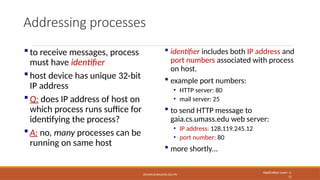




![Internet
applications,
and transport
protocols
ZESHAN.KHAN@NU.EDU.PK
Application Layer:
2-16
Application application
layer protocol
transport
protocol
file
transfer/download
FTP [RFC 959] TCP
e-mail SMTP [RFC 5321] TCP
Web documents HTTP 1.1 [RFC 7320] TCP
Internet telephony SIP [RFC 3261], RTP
[RFC 3550], or
proprietary
TCP or UDP
streaming
audio/video
HTTP [RFC 7320],
DASH
TCP
interactive games WOW, FPS
(proprietary)
TCP or UDP](https://image.slidesharecdn.com/cs3001computernetworkschapter2v8-240924015545-c068b63e/85/CS3001_Computer_Networks_Chapter_2_v8-1-pptx-16-320.jpg)
























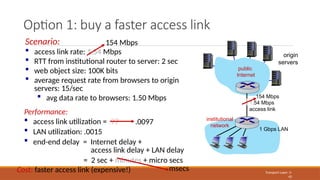
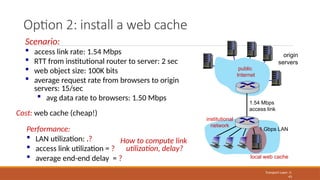



![HTTP/2
Transport Layer: 3-
47
HTTP/2: [RFC 7540, 2015] increased flexibility at server in sending
objects to client:
methods, status codes, most header fields unchanged from HTTP 1.1
transmission order of requested objects based on client-specified
object priority (not necessarily FCFS)
push unrequested objects to client
divide objects into frames, schedule frames to mitigate HOL blocking
Key goal: decreased delay in multi-object HTTP requests](https://image.slidesharecdn.com/cs3001computernetworkschapter2v8-240924015545-c068b63e/85/CS3001_Computer_Networks_Chapter_2_v8-1-pptx-46-320.jpg)
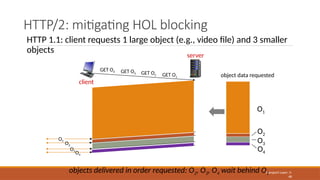









![ZESHAN.KHAN@NU.EDU.PK
Retrieving email: mail access protocols
Application Layer: 2-
58
sender’s e-mail
server
SMTP SMTP
receiver’s e-mail
server
e-mail access
protocol
(e.g., IMAP,
HTTP)
user
agent
user
agent
SMTP: delivery/storage of e-mail messages to receiver’s server
mail access protocol: retrieval from server
• IMAP: Internet Mail Access Protocol [RFC 3501]: messages stored on server, IMAP
provides retrieval, deletion, folders of stored messages on server
HTTP: gmail, Hotmail, Yahoo!Mail, etc. provides web-based interface on
top of STMP (to send), IMAP (or POP) to retrieve e-mail messages](https://image.slidesharecdn.com/cs3001computernetworkschapter2v8-240924015545-c068b63e/85/CS3001_Computer_Networks_Chapter_2_v8-1-pptx-57-320.jpg)











